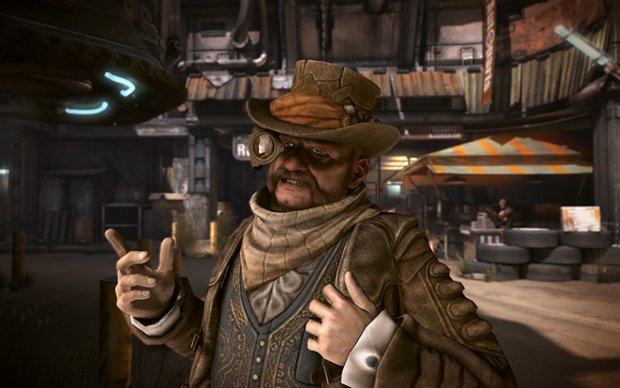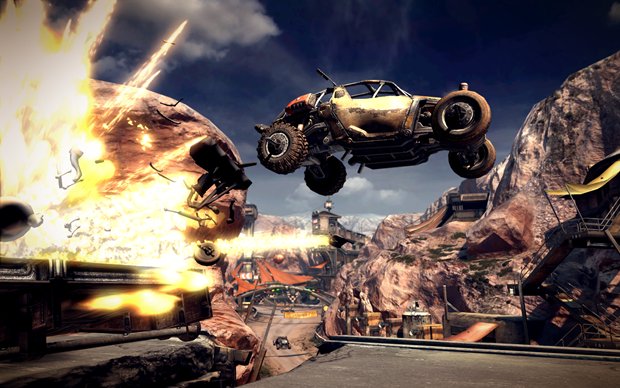RAGE: Five very important things we've learned from the opening two hours
Forget what you know. Here's what you REALLY need to know
3. The racing could carry a game in itself
Seriously, the vehicular component of Rage, which I’d previously feared might be a slightly under-baked tack-on, is good. It’s no F1 2010 in terms of racing simulation, but as arcadey action-driving goes I’ve certainly played worse in dedicated racing games. Whether in an official race or just pottering around the world at large, it’s a combination of light, ultra-responsive handling (180 spins are par for the course as soon as you start using the handbrake at any speeds over starting acceleration) and weighty collision physics, meaning that navigation between areas never becomes a chore, and vehicular jostling always has a satisfying heft.

Whle the racing, particularly the weaponised stuff, is understandably knockabout, a decent understanding of racing lines and the quick-witted opportunism to know when to take advantage of them is just as important as being able to keep sustained gunfire landing on your opponents. That said, I was surprised by just how arcadey Rage’s racing is in practice, albeit in a good way. Part-way through my first race I got my buggy well and truly detonated to high heaven after being pinned down by a rival’s minigun on a long straight. I expected a forced restart of the whole race, with a potential financial penalty for repairs, or even a whole new vehicle purchase. None of it. Just a quick respawn with a couple of seconds racing time to make up, and away I went again. Like I said, this is an action game, not an RPG.
It never feels dumbed down though. It just feels fun. Really, really fun. And with no major penalties for failure, it’s an area of fun that Rage actively encourages you to partake in. And very successfully so.
4. It%26rsquo;s warmer and funnier than the average apocalypse
A satirically amusing and at times batshit bonkers as Fallout 3 undoubtedly is, there’s no denying that the Capital Wasteland can be a bleak place to explore. Between the cold, grey expanses of desert and the robotic shop-window mannequin mannerisms of its inhabitants, extended periods exploring the wilderness are often still a barren and isolating experience. Justin for example, just couldn’t get on with Fallout 3's atmosphere despite the game's brilliance elsewhere, and his stance is certainly justifiable.

Fortunately, Rage’s world has no such problems. While its Technicolor neo wild west take on the days after the end of days will certainly initially put you in mind of Borderlands, a little experience will reveal that it has a feel and humanity all of its own.
Funny and character-driven, but less overtly cartoony than Borderlands, Rage is a wonderfully vibrant, living place to spend time. It helps that, at least during the first few hours, it’s a far less sparse and spread-out environment than Fallout’s, the density of population and man-made scenery straddling a smart balance with just enough travelling time to break up the action and create a sense of real scale.
But just as important is Rage’s character cast and writing. While the dialogue I’ve experienced so far has been fun and personable (not to mention very well delivered), perhaps the most affecting element is a much subtler one. Rage’s character animation, you see, is some seriously expressive stuff. It’s nothing overly exaggerated. There are no dramatic gestures or arm-flailing gotesqueries. But that’s why it works. There’s just a very real weight and physicality to Rage’s inhabitants that suits each individual’s frame and character perfectly. Whether it’s the swinging, whirling-dervish inertia of a rampaging pack of Ghosts, the skidding back-pedal of a rapidly retreating grunt as the tides of battle turn, or just a simple arm gesture by a friendly character in conversation, there’s a warmth, vibrancy and believability to Rage’s animations that makes them feel like something far more than mere computer animations.
Weekly digests, tales from the communities you love, and more
Also item descriptions are funny to a Fable II degree, and the slapstick animation as you crash a bike and flail through the air is so hilarious that a high-speed body-launch became my default way of arriving at any objective almost immediately.
5. Not all versions are (currently) equal
Bit of an unfortunate one, this, but I felt the need to point it out. Obviously right now the PC version of Rage is a visual stunner. And the 360 version isn't far behind. It loses a bit of the crisp, sharp detail and a little of the richness of the PC version (at least on the set-up we had in the room. Your mileage may vary), but unless you're running the two side-by-side, it's nothing you're going to notice. And unless you're very rich and a bit mad, you're not going to be running them side-by-side. The PS3 version though, which is the one I played, was a bit rough. The game ran smoothly, and was a rollicking old good time, but was plagued with texture pop-in on a near-constant basis.

Obviously this was unfinished preview code I was playing, and is currently being bug-checked before the finalised version is sent, so things may well be fine by the time Rage releases in October. But when you're waiting a second or two for environmental textures to properly load in their full detail almost every time your turn around in an FPS, it does become distracting. Particularly when you can see two other versions running right next to you with nocomparable problems. Maybe it's to do with Blu-ray's notoriously slow data streaming having trouble with the new mega-texture technology that makes Rage so beautiful. Either way though, it seems it's an issue that id are aware of, and are hopefully fixing. Because in all other respects, Rage is currently one of this year's most exciting prospects.
August 02, 2011



